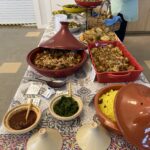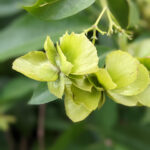Roselle, Jamaica, Florida cranberry, Jamaican Sorrel
Malvaceae Family
Native to: West Africa
Researched by: Julia Johnson
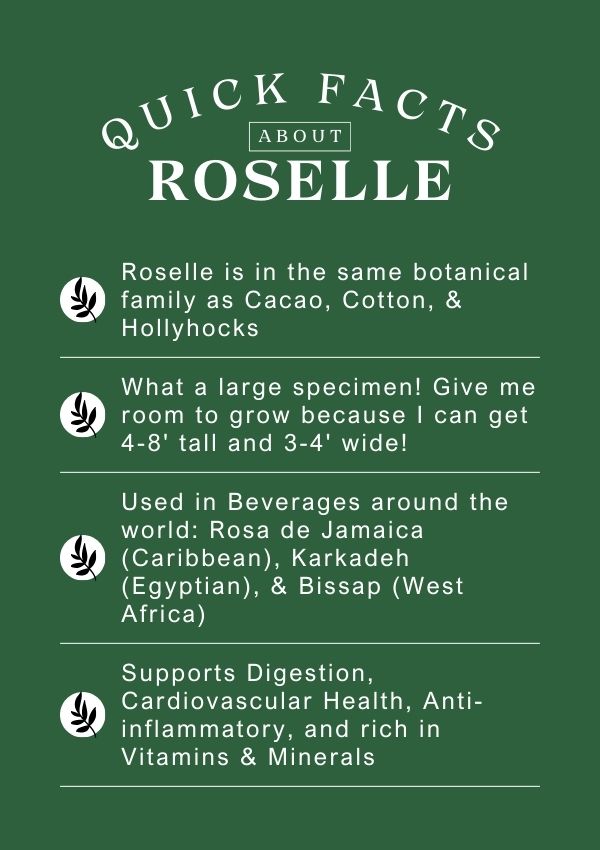
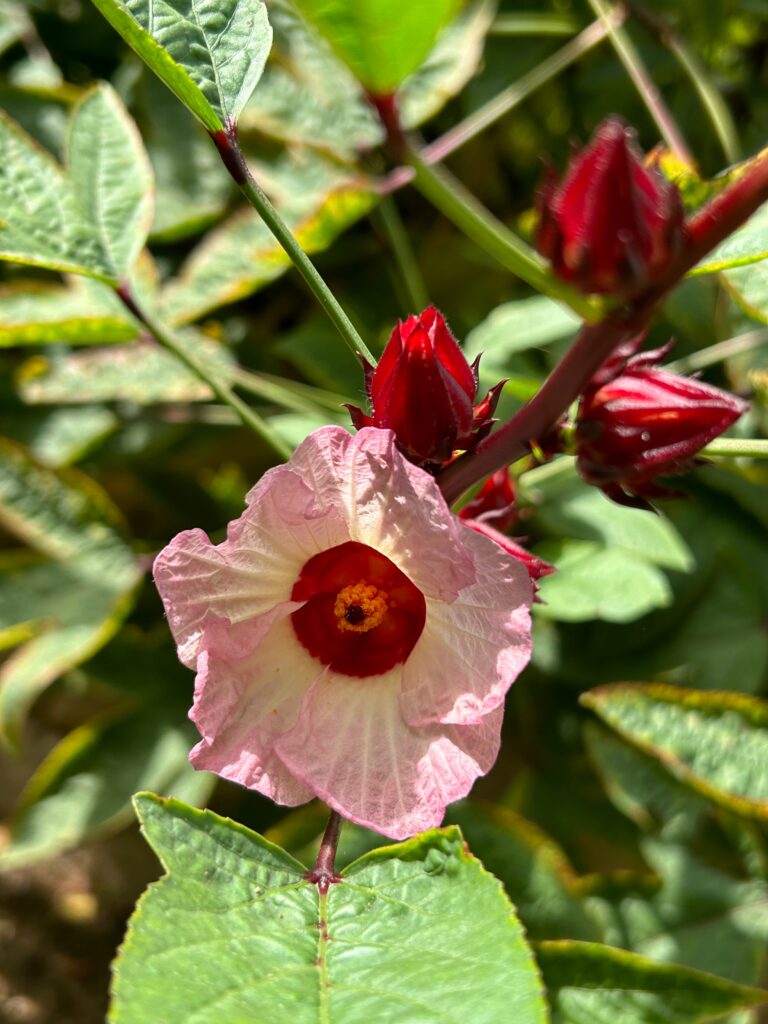
Botanical Family:
Malvaceae, the Mallow family, which includes popular flowering plants such as Alcea (Hollyhocks), Malva (Mallows), Tilia (Linden Tree), Theobroma (Cacao), Gossypium (Cotton) and Abelmoschus esculentus (Okra).
Cultivation:
This tropical annual thrives in humid tropical conditions, with fertile well-draining soil in a sunny location. Seeds germinate best when soil temperatures reach 75-85 degrees and have been soaked in water prior to planting.
Roselle is a large specimen and can reach 4-8’ tall and 3-4’ wide. It is grown as an annual woody subshrub and should be spaced at least 3-6’ apart. The long arching branches may need support as the edible calyces develop.
BLOOMS :
Showy flowers 3-4” in diameter of white, pale yellow, or blush pink develop midsummer through fall. Long, hot summers are needed for the flowers to fully develop for a harvest. After blooms fall off, the seed pod will begin to develop and calyces swell. 7-10 days after bloom drop is the best time for harvesting calyx.
FOLIAGE :
Tropical leaves are 3-6” and deeply lobed, typically green, often with a reddish tint at the base or on new growth, red stems and veins are striking in the landscape.
ENVIRONMENTAL ASPECTS :
A great pollinator plant that is not generally favored by deer or rabbits, even though it is non-toxic to both animals and humans. Does not have invasive tendencies.
COMMON PESTS & DISEASE :
Aphids, spider mites, and whiteflies can develop, control with insecticidal soap or miticide. Powdery mildew can develop on crowded plants, increasing air flow around the plant can help. Root-rot can develop with overwatering or poor drainage which will lead to the death of the plant.
Applying a balanced fertilizer throughout the growing season can help prevent nutrient deficiencies. Nitrogen deficiency often causes poor growth and yellowing on older leaves. Potassium deficiency can cause leaf edges to turn brown or yellow. Magnesium deficiency causes interveinal chlorosis on older leaves, the leaves will start to yellow between veins, a magnesium sulfate (Epsom salt) solution can be added to the soil or sprayed on the foliage.
TOXICITY CONCERNS :
Hibiscus sabdariffa is not toxic to animals or humans, and is widely consumed as a popular beverage in tropical regions of the world like Africa and the Caribbean. However it is always important to ensure that any plant material is properly prepared before consuming.
Folklore & Traditional Uses:
Hibiscus sabdariffa is believed to have originated in tropical regions of Africa, with evidence dating back to its use in Sudan around 4000 BC. It was initially cultivated for its edible seeds, then its foliage, young shoots, and flower parts were used for food and medicine. It became well-known for its fleshy calyces which have been used in many regions of the world for jams, beverages, and other food items.

ANCIENT EGYPT:
In ancient medicine, this plant’s vibrant red calyces were infused into teas and other decoctions to treat sore throats and coughs while supporting kidney health, as noted in the Ebers Papayrus, an ancient medical document.
A special drink known as Karkadeh, or “Tea of the Pharaohs,” is believed to have been consumed by Egyptian royalty and was made from Hibiscus sabdariffa. Traditional practices like applying poultices recognized this plant’s antibacterial and anti-inflammatory properties.
Also valued for its deep red pigment, the calyces were used to dye fabrics used for ceremonies and for the socially elite. These pigments extended to regions like Sudan and Asia, making the plant a symbol of status.
Even today, parts of Egypt use Karkadeh in wedding toasts to the bride and groom; this vibrant red drink is a symbol of vitality and joy!
AFRICA:
Roselle has been a staple for both medicine and food. Here, seeds are often roasted and ground into a seasoning. The calyces are made into a popular tart beverage known as Carcade (Karkadeh) or Bissap (often infused with mint), which can be used to lower temperatures associated with heat stroke and improves cardiovascular health.
This plant was brought to the Caribbean during the slave trade by Africans as use for food and medicine. It has thrived in these tropical regions and today is cherished in a Caribbean Christmas drink called Rosa de Jamaica, often spiced with ginger and cinnamon.
ASIA:
Roselle made its way through Asia and by the 16th century it was an integral part of Indian medicine. The Zeliang tribes of Nagas in Northeastern India used this plant to treat stomach disorders and to purify the blood. It was also used by the Meites tribe to treat urinary tract infections.
AUSTRALIA:
Used particularly in the Indigenous communities of Queensland, fiber from the bark of Roselle has been used to create dilli bags, twine, and hunting nets, in addition to the other traditional usages.
Modern & Medicinal Uses:
Roselle has a flavor that is similar to cranberries, though less bitter, and with lemon undertones. It is refreshing and tangy due to the presence of citric and malic organic acids. Blooms, leaves, calyces, and seed pods are all edible.
Leaves are often used in salads or as cooked greens which taste like a spicy spinach. In Middle Eastern and African cuisine Roselle is added to soups and stews for acidity and depth of flavor. Leaves and seed pods contain natural pectins which can be useful when making jams, jellies, and chutneys. Chutneys made with Roselle are used to complement pork or duck dishes.
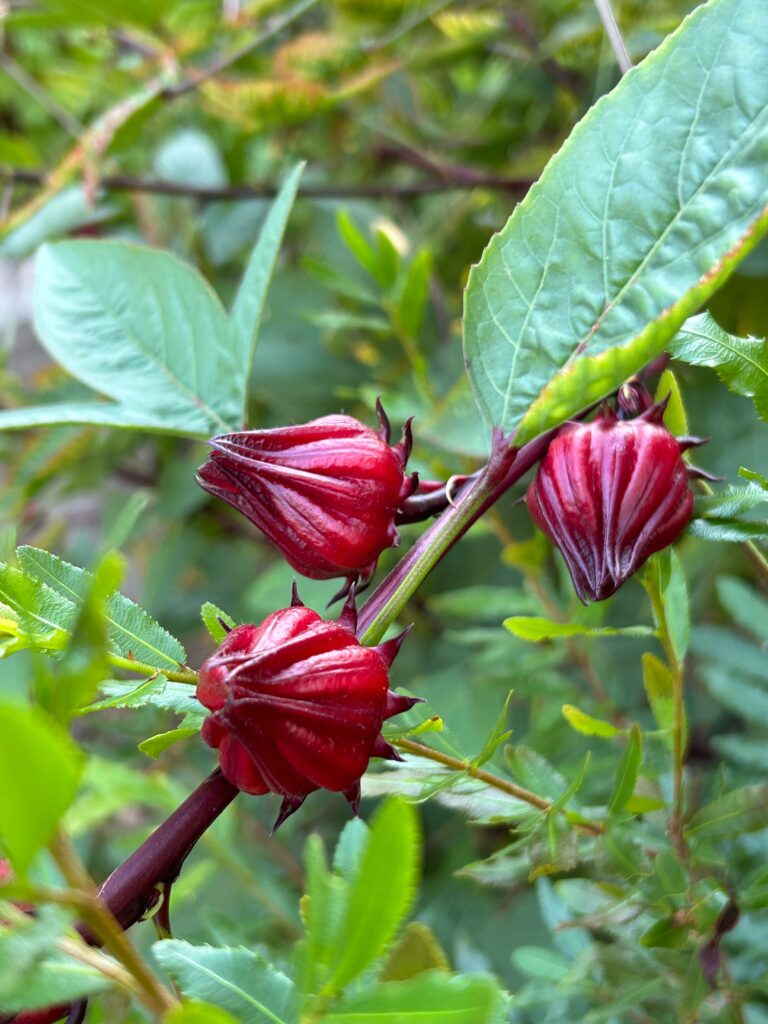
Try adding fresh calyces to your green salads for a tart and tangy addition full of vitamin C. Fresh calyx are an attractive garnish on desserts or cocktails, and are even better candied. Dried and ground calyx powder can be incorporated into cakes, cookies, or breads for vibrant color and flavor, or used as a natural food coloring.
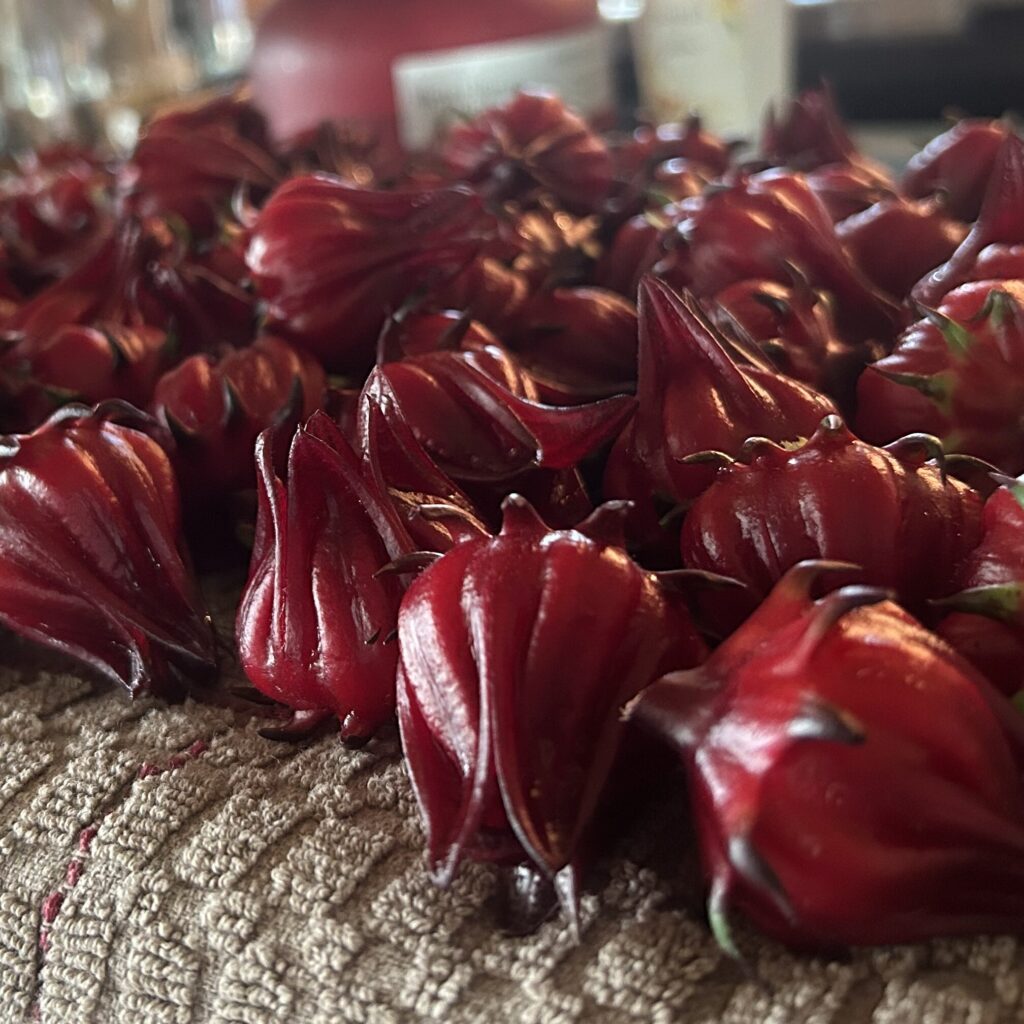
Have too many calyces? Pluck them off the seed pods and dehydrate for storage. I like to put mine in vacuumed-sealed mason jars. They make such a tasty and nutritious tea.
SELF-CARE:
Roselle extract is high in antioxidants and can be used in anti-aging creams and serums. It is also used as a natural color and moisturizer in lip balms. If you infuse some Hibiscus sabdariffa into your natural shampoo or conditioner it will lend extra shine and strength to your hair.
NUTRACEUTICALS:
Health supplements can combine Roselle with other nutritious botanicals to help boost your mood and health.
Medicinal Uses:
DIGESTIVE HEALTH :
Traditionally used to aid digestion and relieve constipation. May assist in weight management by reducing appetite.
CARDIOVASCULAR HEALTH :
Hibiscus tea is known for its potential to lower blood pressure and studies show that the anthocyanin content helps to reduce the risk of atherosclerosis by preventing the oxidation of LDL cholesterol. Regular consumption of this herb may improve lipid profiles and triglyceride levels contributing to overall cardiovascular health.
ANTI-INFLAMMATORY :
Rich in antioxidants and anthocyanins, Hibiscus sabdariffa can help neutralize free radicals and reduce oxidative stress. Anthocyanins give Roselle its vibrant red color and offer anti-inflammatory benefits. Flavonoids like quercetin and kaempferol protect cells from oxidative stress. Polyphenols help combat free radicals in the body.
KEY VITAMINS & MINERALS :
100 g of Calyces contains: 14 mg Vitamin C (boosts immunity and collagen production), 51 mg Magnesium (crucial for muscles and nerves), 208 mg Potassium (aids in blood pressure regulation), 3.3 mg Iron (prevents anemia and supports oxygen transport)
100 g of leaves: 215 mg Calcium (supports bone health)
REACTIONS : If allergic to other members of the Malvaceae family, you may develop a rash when using Roselle as well, although this appears to be very rare. If taking medications, always consult your healthcare professional before trying new herbs as they may interfere with the medications you are taking. Since Roselle has beneficial effects on blood pressure and blood sugar, it may interfere with drugs controlling those levels in your body.
Pregnancy Concerns : Avoid during pregnancy as it can potentially cause uterine contractions.
Recipes:
Rosa de Jamaica (Hibiscus Tea)
Ingredients:
- 2 quarts Water
- 1 cup dried Roselle calyces
- 1/2 – 1 cup Sugar, to taste
- 1 cinnamon stick
- Lime slices, garnish
- Lime juice, optional
Instructions:
- Combine 4 c water and sugar in medium saucepan. Add cinnamon stick bring to a boil, simmer 5 minutes until the sugar is dissolved. Remove from heat.
- Add dried Roselle (hibiscus) calyces to steep in hot liquid, covered for about an hour.
- Strain the tea into a pitcher, refrigerate the concentrated drink until ready to serve.
- Add remaining 4 cups of water before serving, either still water or seltzer.
- Garnish with a lime slice, and a splash of lime juice if desired!
Optional – Add allspice berries or a couple of sliced of ginger with the cinnamon stick gives great flavor! Orange slices or mint are often used as garnish.
https://www.mayanhands.org/blogs/news/rosa-de-jamaica
Roselle Jam
Ingredient:
- Rosellas
- Sugar
- Water
- 1 teaspoon of butter
- The juice of 1 lemon
Directions:
- Separate red calyxes from the seedpods
- Wash and drain each seperately.
- In a saucepan, add seeds and water until the seeds are just covered. Tip: (Add a little extra water to the seeds, at this stage, if necessary, rather than adding extra later)
- Bring to boil and cook covered, for 30 minutes.
- Strain and reserve the juice in a second saucepan. The seeds can now be discarded.
- To this juice, add the red calyxes which have been thoroughly washed and drained. The calyxes may not be completely covered with juice, but they will boil down very quickly.
- Boil for 20 minutes until a ‘pulp’ is formed
- Measure the volume of cooked pulp and return to pan. (measurment is needed for step 10)
- Add one good teaspoon of butter, and the juice of one lemon.
- Add an equal amount of warmed sugar to pulp. For example add 1 cup of sugar to each cup of pulp, stirring well till all the sugar is completely dissolved. (pre-warm sugar on a heat proof tray, in a oven on low heat)
- Boil quickly uncovered for 20 minutes or until jam falls thickly from a spoon when tested.
Delicious on toast, scones, or pancakes- or even as a chutney. You’ll find lots of way to whip this jam into spectacular treats!
https://www.theseedcollection.com.au/blog/Rosella-Jam
Hibiscus Syrup
Ingredients:
- 1 cup water
- 1 cup dried Roselle calyces
- 1 cup sugar (or honey)
Directions:
- In a small saucepan bring above ingredients to a light boil, simmer for 10 min. Turn off heat and cool for about 10 minutes.
- Strain syrup, bottle and keep refrigerated until use.
Makes great cocktails like a Hibiscus Paloma, Hibiscus Margarita, or even a Hibiscus Honey Mint Julep. This syrup can add a great splash of color to champagne, lemonade, or iced tea. Try it mixed with powdered sugar for a brightly flavored and colored glaze for cakes.
References:
“Roselle”, Gardenia, https://www.gardenia.net/plant/hibiscus-sabdariffa-roselle-grow-care-guide, Accessed on : 12/30/2024
Katherine, “Roselle Hibiscus: Health benefits, Growing tips, & Versatile uses…”, Hibiscus Hive, 2024, https://hibiscushive.com/roselle-hibiscus/, Accessed on : 1/25/2025.
Katherine, “Hibiscus sabdariffa: Health Benefits…”, Hibiscus Hive, 2024, https://hibiscushive.com/hibiscus-sabdariffa/, Accessed on : 1/25/2025.
Bayton, Dr. Ross and Simon Maughan. RHS Genealogy for Gardeners. London : Quarto, 2017. Print.
“Hibiscus”, White Rabbit Institute of Healing, 2014-2024, https://www.whiterabbitinstituteofhealing.com/herbs/hibiscus/, Accessed on : 1/25/2025.
“Herbs in History: Hibiscus sabdariffa”, Australian Medicinal Herbs, 2025, https://australianmedicinalherbs.com.au/blogs/news/hibiscus-sabdariffa-a-historical-perspective, Accessed on : 1/25/2025.
“Rosa de Jamaica”, Mayan Hands, https://www.mayanhands.org/blogs/news/rosa-de-jamaica, Accessed on : 2/13/2025.
“How to make Rosella Jam”, The Seed Collection, https://www.theseedcollection.com.au/blog/Rosella-Jam, Accessed on 2/13/2025.
Return to Africa Region
Return to Pharmacy Garden




